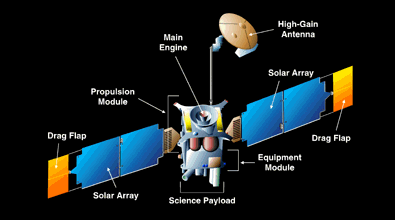![]()
![]()
 |
Designing a robust machine to gather data that will yield clues into the mystery of Mars is not an easy task. Consider the fact that from launch in November 1996 to the completion of mapping in January 2000, Surveyor must operate without major malfunctions. If a component on the spacecraft breaks, no means exist to send a repair crew to Mars.
The Surveyor spacecraft, fabricated at the Lockheed Martin Astronautics plant in Denver, appears nothing like the Space Shuttle or the saucer-shaped UFOs depicted by Hollywood over the last half century. Instead, Surveyor looks like a rectangular-shaped box with wing-like projections extending from opposite sides.
When fully loaded with propellant at the time of launch, the spacecraft weighed only 1,060-kilograms (2,342 pounds). Most of Surveyor's mass lies in the box-shaped module occupying the center portion of the spacecraft. In reality, this center module is made of two smaller rectangular modules stacked on top of each other. One of the two smaller modules, called the equipment module, holds all of the spacecraft's electronics and science instruments. The other, called the propulsion module, houses Surveyor's rocket engines and propellant tanks.
Basic Engineering Data on Spacecraft
Engineering Data on the Subsystems of the Spacecraft